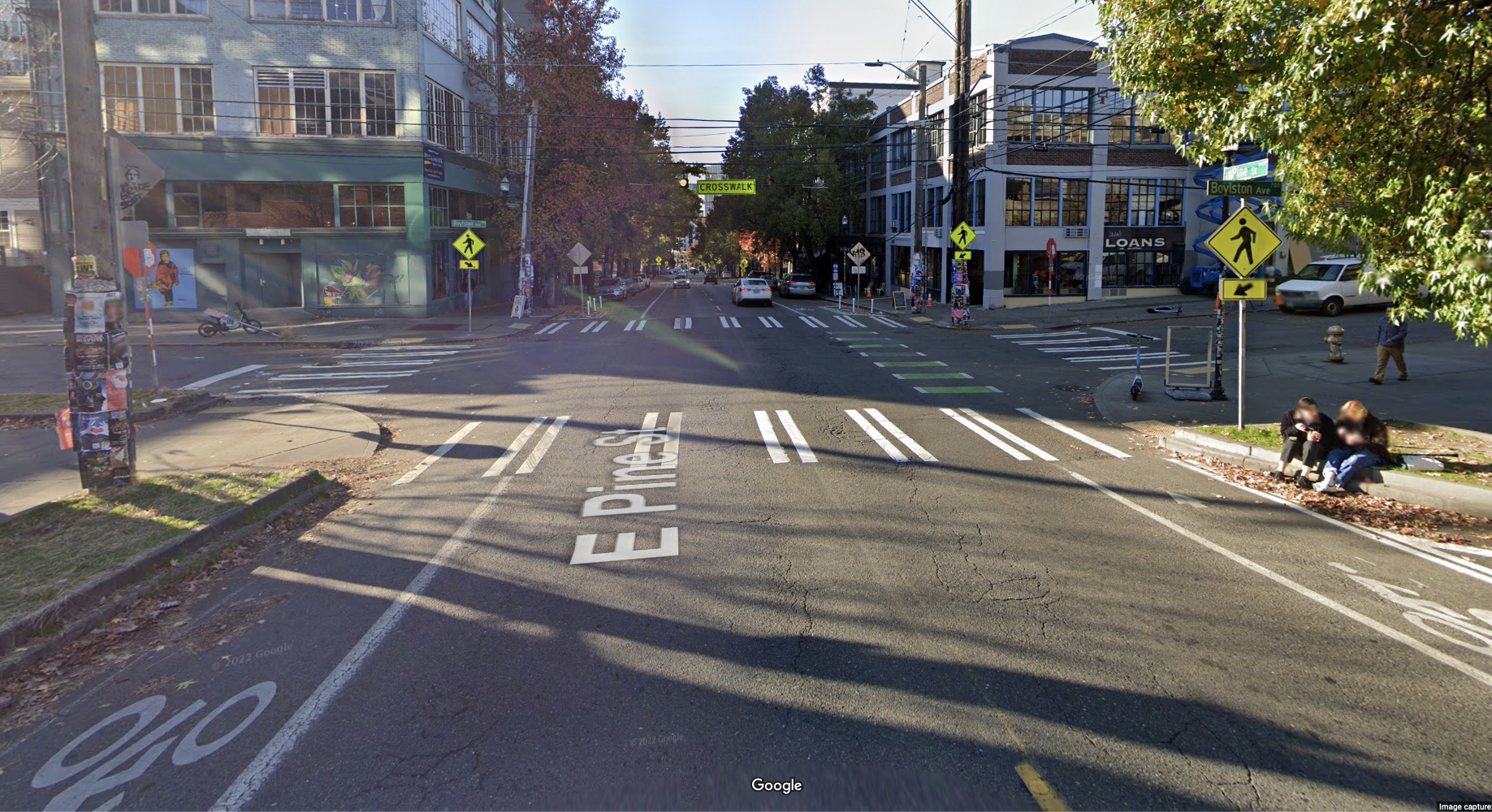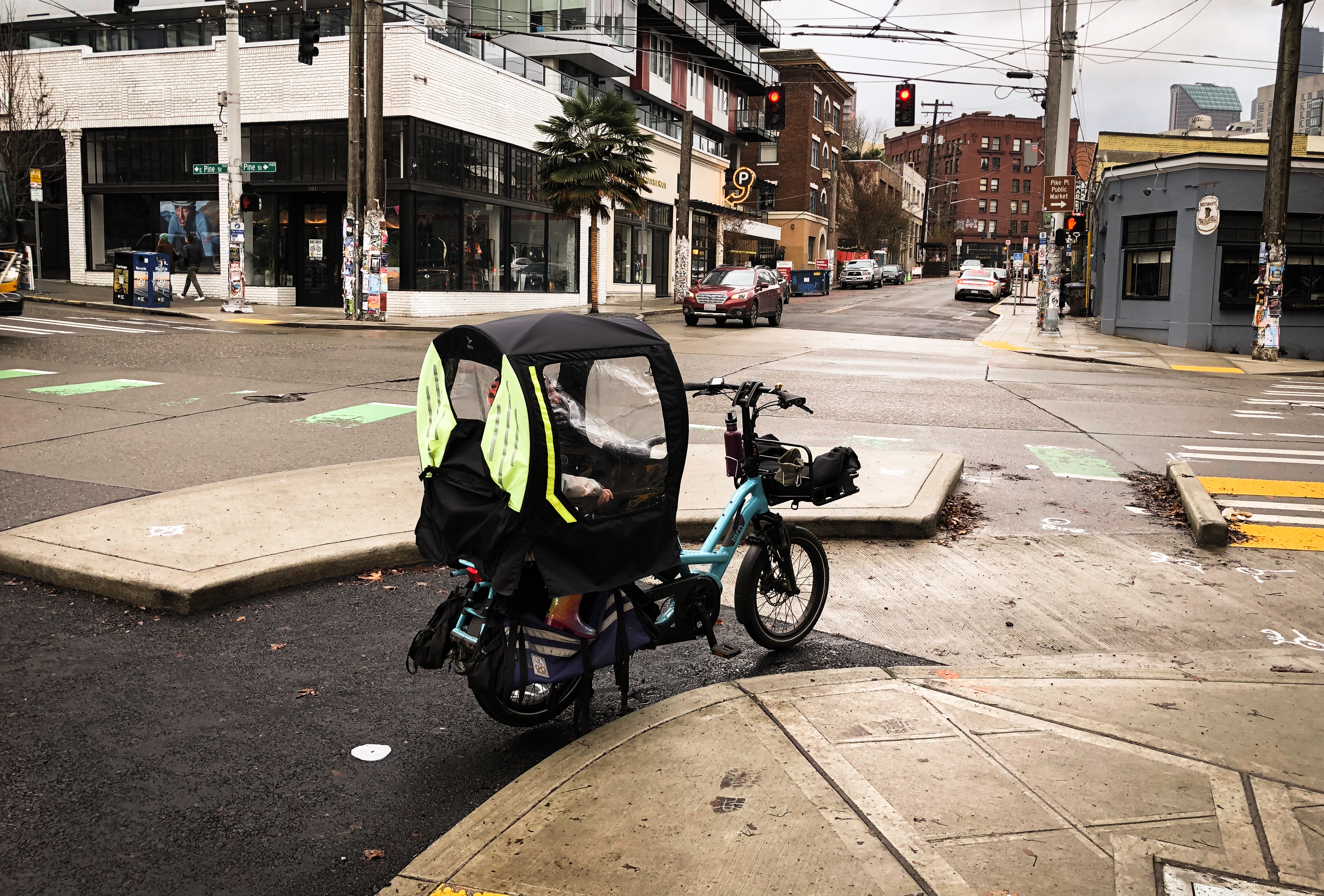
Here’s a somewhat unexpected note from SDOT:
To enhance safety for people walking & rolling, we’re adding more 4-way stop signs on Pine St in the ❤️ of #CapitolHill. Crews worked in wind & rain today to add signs at Summit Ave & Boylston Ave. We’ll add one more at Belmont Ave as soon as weather allows. #VisionZero @jseattle
SDOT has long resisted adding all-way stops, especially for situations where one street is clearly busier than the cross street. There are a number of reasons for this, some of which are legit and some of which are, well, questionable. It will be very interesting to see how stop signs function on Pine, a major connection between Capitol Hill and downtown that serves as a busy bike route and bus corridor while also traveling through one of the city’s most walkable neighborhood business districts.
The most notable effect of stop signs is that compliance for yielding to crosswalk users should go way up. This is likely the primary reason for these signs on Pine. People driving are already required to stop for people crossing the street, but they don’t always do so. Any since there is nearly always someone trying to cross Pine, the stop signs here will hopefully lead to safer and more comfortable crossings. Stop signs should also have a traffic calming effect since people will not be able to build up speed over multiple blocks, something that is especially important on such a long downhill like westbound Pine.
All-way stops can also be more efficient for all road users compared to traffic signals in many situations. U.S. cities have frankly gone way overboard with their use of signals, which are really only needed for the busiest or most complex intersections. For example, SDOT ran an experiment at NE 40th Street and The Ave in the U District back in 2014 and found that turning that traffic signal into an all-way blinking red light decreased delays for all users in all directions. So rather than upgrading the signal to accommodate the new two-way bike lane there, they have just left the red lights blinking ever since.
All-way stops are very cheap to implement and give crosswalk users the right of way by default, which is a huge win for walkability compared to a traffic signal with a Don’t Walk phase. That all sounds great, so what’s the downside?
This is where we get into some questionable traffic engineering assumptions and practices. There is this idea within traffic engineering that if you install too many stop signs, people will stop obeying them. Therefore, most traffic engineers subscribe to the idea that they should only install stop signs in the most important locations where the signs are “warranted.”
But context matters more than anything else. For example, there’s a street back in my hometown St. Louis, Missouri, called Jamieson Avenue that I used to drive on all the time. It is a five-lane neighborhood street (two in each direction plus a center turn lane) that passes by a park and business district (I miss Mom’s Deli). To handle the neighborhood’s need to cross this giant street, traffic engineers installed crosswalks with stop signs at multiple locations. People hate these stop signs. The street looks and feels like a highway, and people typically just roll through them rather than stopping. The problem is that the street is far too wide and has too many lanes in order for stop signs to work effectively. You could say that installing too many stop signs has reduced the effectiveness of the signs, but really the street’s context was just wrong for stop signs. They should have reduced the street width and given it a complete streets redesign in order to slow traffic and make the crosswalks more effective.
So is Pine Street the correct context for stop signs? I am very interested to find out. And we should be prepared for the answer to be, “No” or “Meh.” A stop sign is a very low-cost tool that is surely an important strategy for creating more quality crossing opportunities along our city’s many streets on which people driving consistently fail to yield to people in crosswalks (marked and especially unmarked). However, the best solution is a street design in which all traffic is calmed to the point that no stop signs are even needed. Not Just Bikes made a video about this a few years ago:
Of course, it takes a lot more work, money and time to completely redesign a street, and there are not too many U.S. examples that work quite like the Dutch streets in that video.
SDOT is in the process of building the city’s first “protected intersection” at Pine and Melrose as part of both the Melrose Promenade and Pike/Pine Renaissance projects. Currently, only one of the corners is constructed, and it doesn’t fully connect into the bike lane network yet. But it’s an interesting glimpse into the benefits of building a curb within an intersection to slow turns and protect bike lanes and crosswalks. It is not exactly like a Dutch intersection (for example, it has a stop signal), but it is a great opportunity for the city to learn more about how to build and operate intersections that include separated and curbed protection for people walking and biking. I would love to see the city trying out these ideas in many more locations around town, because getting it right and being able to scale up installation of protected intersection would be game-changing for traffic safety in Seattle.









Comments
9 responses to “City will add series of all-way stops to Pine Street on Capitol Hill”
I’ve got to experience the effect myself very soon. I often ride to Hot Mama’s Pizza by riding up Pine from downtown. Since it is on the opposite (i.e. north) side of the street, I’ve often had to stop at the intersection with Boylston and wait for the cars on Pine to go by before turning left to reach the pizza place. That’s one of the locations SDOT has just installed the stop signs, according to this article. Ideally, I will just get ahead of the car that just stopped at the sign and cross diagonally, but that assumes they do make a full stop as required by the law. Let’s see.
No mention of flashing crosswalk lights? They seem like a good alternative to stop signs in many cases. Realistically, it’s often tough for drivers to tell who is waiting to cross the street and who is just standing around in the vicinity of a crosswalk.
With a stop sign in place, drivers don’t have to tell whether or not people are waiting at the crosswalk. They must legally stop regardless.
I’m a little iffy on flashing crosswalk lights. We’ve given them a good try, and they just aren’t as good as I wish they were. When they work and have bike-accessible buttons or detectors, they can be helpful. But they keep breaking, and then you have to rely on the local agency to care enough to fix them in a timely manor. They are also surprisingly expensive to install. For a crosswalk project with a decent budget, I’d much prefer curbs to shorten crossing distances or a raised crosswalk. Those don’t require much maintenance and are more effective.
The other downside to the flashers vs. stop signs or raised crosswalks is they don’t cause most drivers to drive slower when the signal is off. And in my experience a lot of drivers going 25-30+ won’t stop for the flashing lights anyway, or they have to slam on their brakes to not hit someone which is terrifying in a different way!
I only have experience with three crossings with three of them at Genessee & 37th, S. Jackson & 25th, and E. Yesler & 26th. Basically for me on a bike, only about 2-3 drivers out of 10 will stop.
Since I can’t count on drivers stopping consistently enough to risk crossing in front of cars traveling east-west on these streets, I end up waiting until there’s no cross traffic.
For me the flashing beacons at these intersections are useless. After I realized that I quit pressing the buttons for the flashing beacon and started treating them like any other uncontrolled intersection.
They seem to work better for pedestrians. Drivers just aren’t used to stopping at them to let bikes cross. They probably don’t even realize that was part of SDOT’s intent when they installed them.
“They seem to work better for pedestrians. Drivers just aren’t used to stopping at them to let bikes cross.”
This is my experience as well; I’ve experienced this multiple times on Othello when trying to cross on the neighborhood greenway. I’ll press the bike accessible button and inch out so I’m visible. People glance at the curbs, see no pedestrians, and I imagine they think whoever pressed the button has crossed already. They perceive me as a vehicle that must yield. And technically I’m not sure if state law says that they should yield to me.
That said, I do think the flashing lights catch driver’s eyes, and may make all users more visible once they are already in the crosswalk.
I walk down Pike street very often where they installed 4 way stops a year ago or so. It made a big change in slowing drivers down and getting people to actually stop for people crossing on foot. I’m optimistic that it will have the same effect one block over.
The “Dutch crossing” treatment would be even better but stop signs is a good first step for places like this where people walking vastly outnumber cars. Roundabouts are better than stop signs, but in a city where drivers haven’t learned to yield to people walking, I’ll take the stop signs any day.
I would love to have a stop sign or other way to calm the cars that speed up and down Belmont Pl especially at Roy and Lakeview. Everyday I worry I will be hit by a car. 10th Ave at Prospect is also a very scary crosswalk. The cars blow down the street because it’s straight and wide and go right through the crosswalk even when I’m in it. Some of them even honk at me. Please slow them down! Put in speed bumps or something to calm it down. People cross there frequently to go to the park.